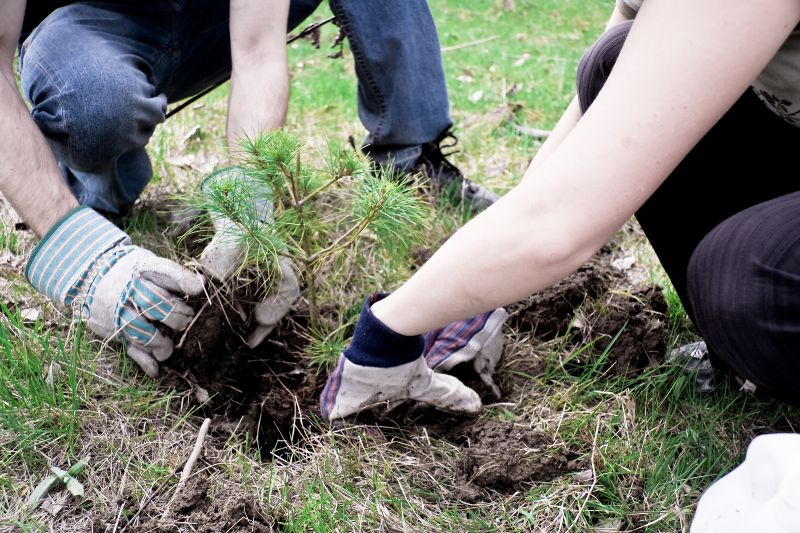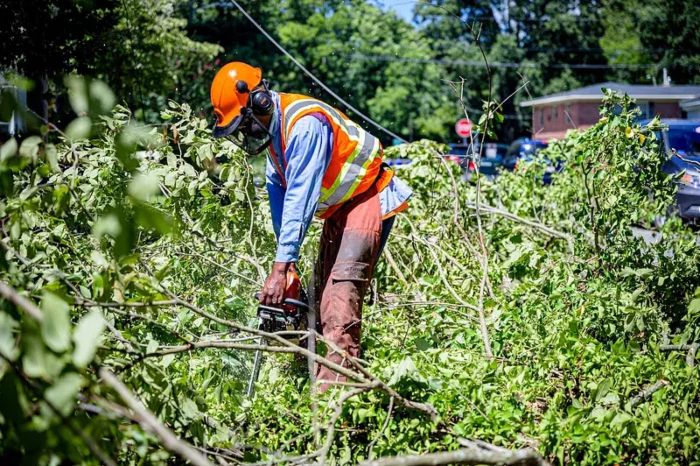Tree removal is sometimes an unfortunate necessity, due to disease, safety concerns, or landscaping changes. After tree removal, you may be wondering, “what should I plant in its place?” Trees are a long-term investment, so make sure you research thoroughly before choosing the right replacement. With our guide, you’ll find some expert info on replanting and pro tips to help your next planting be a success!
Why Plant After Having a Tree Removal?
Replanting after tree removal provides many benefits:
- Restore Environmental Benefits: Trees provide shade, improve air quality, support wildlife, and reduce soil erosion.
- Improve Property Aesthetics: Replacing a removed tree with a new, healthy one enhances the appearance of your landscape, creating an inviting outdoor space.
- Increase Property Value: Trees can boost property value (link to our blog, “Impact of Trees on Property Value”). A well-maintained landscape with mature trees can make your property more attractive to potential buyers.
- Maintain Privacy and Noise Reduction: Trees are natural barriers that provide privacy and reduce noise from surrounding areas.
7 Tips For Planting After Tree Removal
Here are seven pro tips to help ensure your new tree thrives!
- Stump Grinding: After tree removal, the stump should be ground down to below the soil level. Stump grinding removes the root ball and clears the area, making it easier to plant a new tree. Remaining stumps can be trip hazards and some tree stumps can grow back.
- Choose the Right Tree for the Right Place: Assess your site conditions, including sunlight, soil type, and space availability. Choose a tree that matches these conditions for the best chance at success. For example, drought-tolerant trees are ideal for dry areas, while shade-loving trees thrive in less sunny spots.
- Plant at the Right Depth: Planting a tree at the wrong depth is one of the most common mistakes! The tree’s root flare, where the roots spread from the trunk, should be at or slightly above ground level. Planting too deep can suffocate the roots, while planting too shallow can expose roots to damage.
- Water Properly: Water regularly during the first few years. Download our New Tree Watering Guide! Avoid overwatering, which can lead to root rot, and adjust your watering schedule based on rainfall and weather conditions.
- Mulch: Mulch helps to retain moisture, regulate soil temperature, and suppress weeds. Use organic mulch, such as wood chips or bark, and keep it a few inches away from the trunk to prevent rot.
- Monitor for Pests and Diseases: Young trees can be vulnerable to pests and diseases. Regularly inspect your tree for signs of distress, such as discolored leaves or abnormal growth. Early detection and treatment can prevent serious damage.
- Consult an Arborist: Professional arborist consultation can provide expert advice on tree selection, planting, and ongoing care specific to your concerns and site conditions.
Check out our Tree Planting Do’s and Don’ts to learn more!

The Best Trees to Plant After Tree Removal
At a loss for what to plant? Here are some popular trees that adapt well to most landscapes:
– Maple Trees: Known for their stunning fall foliage, maples are great for adding color and shade to your yard.
– Dogwood Trees: These trees are small, ornamental options that bloom beautifully in spring and adapt well to various soil types.
– Oak Trees: Oaks are long-lived and robust, providing shade and habitat for wildlife.
– Crepe Myrtles: Perfect for adding color, these trees bloom profusely in summer and have attractive bark and foliage year-round.
– Redbud Trees: With vibrant pink flowers in early spring, redbuds are excellent for adding a burst of color.
And always consider the growth habits, maintenance needs, and space requirements of each tree to ensure a happy new tree!
Tree Removal Permit
Before planting a new tree, it’s important to understand local regulations regarding tree removal and replanting. Many municipalities require permits for tree removal, especially for protected species or trees in designated areas. Failing to obtain a permit can result in fines and other penalties. Check with your local city or county offices to ensure compliance with tree removal and replacement requirements.

Tree Care For Newly Planted Trees
After the new tree is in the ground, make sure it has proper care to improve growth and establishment:
– Regular Watering: Consistent watering is vital during the first two to three years. Many young tree failures result from under and over watering.
– Pruning: Light pruning helps shape young trees and removes any damaged or diseased branches. Avoid heavy pruning that could stress the tree.
– Soil health: Mix slow-release fertilizers, soil amendment, and beneficial soil microbes into the native soil to improve root growth and tree establishment.
– Protection: Guard young trees against animals, lawn equipment, and harsh weather conditions by using protective tree guards or staking. Remember to replace or remove protection as the tree gets larger.
How Should Grass Be Planted After Tree Removal?
If you prefer to plant grass instead of a tree after removal, follow these tips:
– Remove Debris: Clear away wood chips, roots, and other debris left after stump grinding. This helps create a clean slate for grass seed or sod.
– Amend the Soil: Add organic matter, such as compost, to improve soil structure and fertility, especially if the tree previously depleted nutrients.
– Level the Ground: Smooth the soil surface to eliminate any bumps or low spots that could affect grass growth.
– Seed or Sod: Choose grass seed or sod that suits your climate and sunlight conditions. Water thoroughly after planting and keep the soil moist until the grass is established.
Choose Trusted Tree Service Company
With more than 20 years of experience, A Plus Tree is your trusted partner in safe tree removal, proper tree planting, and expert tree care guidance. Our team of Arborists will assess your property, recommend the best trees for your needs, and provide ongoing care to keep your trees thriving. Fully licensed and insured, we are well equipped to perform all your tree care needs safely and professionally. Reach out today for a free assessment!





